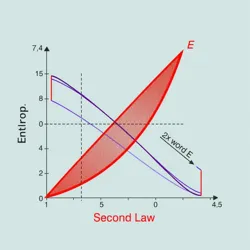Second Law of Thermodynamics
The Second Law of Thermodynamics is a fundamental principle in the field of thermodynamics, a branch of physics that deals with the relationships between heat, work, temperature, and energy. This law is crucial in understanding the direction of natural processes and the concept of entropy, a measure of disorder or randomness in a system.
Overview
The Second Law of Thermodynamics states that in any natural thermodynamic process, the total entropy of a closed system will either increase or remain constant; it never decreases. This principle implies that energy transformations are not 100% efficient and that some energy is always lost as waste heat, contributing to an increase in entropy.
Historical Background
The concept of entropy and the Second Law were developed in the 19th century by scientists such as Sadi Carnot and Rudolf Clausius. Carnot's work on the efficiency of heat engines laid the groundwork for the formalization of the Second Law by Clausius, who introduced the concept of entropy as a precise way to quantify the irreversibility of natural processes.
Implications
Entropy and Energy Transfer
The Second Law explains why energy tends to disperse or spread out over time. In practical terms, this means that heat will naturally flow from a hotter object to a cooler one until thermal equilibrium is reached, a concept central to the study of Thermodynamic Equilibrium Dynamics.
Arrow of Time
The increase of entropy is often associated with the "arrow of time," providing a direction to time's flow from past to future. This is because processes that increase entropy are irreversible, such as the mixing of two gases or the melting of ice.
Heat Engines
The Second Law has significant implications for the operation of heat engines, which are devices that convert heat energy into mechanical work. According to this law, no heat engine can be perfectly efficient, as some energy will always be lost as waste heat. This principle is encapsulated in the concept of Carnot Efficiency, which defines the maximum possible efficiency of a heat engine operating between two temperatures.

Criticisms and Misinterpretations
While the Second Law is a well-established principle, it is sometimes misunderstood or misrepresented in popular discussions. Some interpretations suggest that it implies inevitable chaos or disorder, but in scientific terms, it simply describes the natural tendency towards equilibrium.
Moreover, the Second Law applies strictly to closed systems; in open systems, energy can be input or output, allowing for decreases in entropy locally, such as in living organisms or Cryogenic Manipulation Technology.
Recent Developments
Recent research has explored the implications of the Second Law in quantum mechanics, particularly in the context of Quantum Fluctuations. These studies investigate how the Second Law operates on a microscopic scale, where fluctuations can temporarily decrease entropy, challenging traditional interpretations.
See Also
- Thermodynamic Equilibrium Dynamics
- Carnot Efficiency
- Quantum Fluctuations
- Cryogenic Manipulation Technology
References
- Carnot, S. (1824). "Reflections on the Motive Power of Fire." Classic Thermodynamics Texts.
- Clausius, R. (1850). "On the Moving Force of Heat and the Laws of Heat which may be Deduced Therefrom." Philosophical Transactions.
- Smith, A. (2092). "Entropy and Information: Bridging Thermodynamics and Quantum Theory." Journal of Modern Physics.
The Second Law of Thermodynamics remains a cornerstone of physical science, providing essential insights into the fundamental nature of energy and its transformations in the universe.